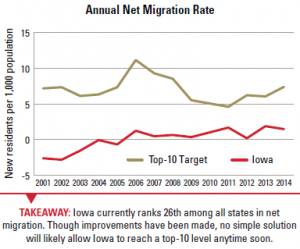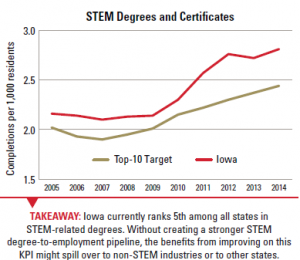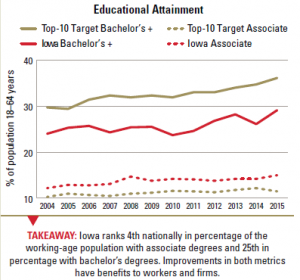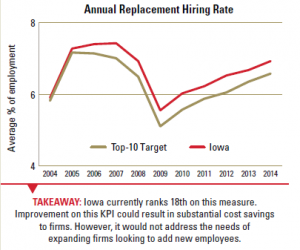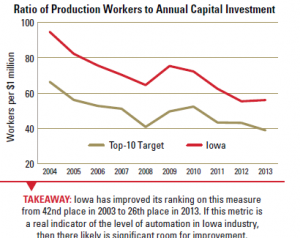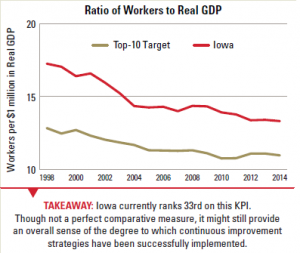Iowa has been working on its workforce for a long time.
The state’s current labor market conditions are challenging employers who seek skilled workers. Some define the problem as a skills gap, others call it an overall workforce shortage, and still others blame current wage levels. Whatever the label, a growing disconnect between Iowa’s workforce supply and employer demands is threatening to weaken the state’s economic growth potential.
So what’s to be done?
CIRAS News has spent the last seven issues highlighting various ways that successful companies have addressed their workforce difficulties. The ideas work. But most businesses can’t afford to try all of the options in perpetuity. Before leaders follow down any particular path, they’re going to want the ability to assess things and know that they’re getting a reasonable return on their investment.
In this, the last article of our Working on Workforce series, CIRAS News explores some key metrics associated with the potential strategies we’ve previously mentioned.
Spoiler alert: We don’t think they’re all created equal. Your view may be different, however, depending on factors that are unique to your company or your region. Numerous best strategies exist for individuals in different situations. We intend to give you the numbers, then highlight the areas that we think may hold the greatest potential for Iowa as a whole.
First, Let’s Review
Workforce is not just an Iowa problem. As unemployment rates fall nationally, fewer people are looking for work and employers must compete harder for new employees. Supply and demand pushes workers to places with more jobs, higher pay, and/or a better living environment. Such national trends are exacerbated in Iowa because of its history of low unemployment, as well as its slow population growth, low net migration, and low wages.
All those factors combine to make any workforce solution complex. Our previous stories (CIRAS News, Vol 49, No. 4 through Vol. 51, No 2) attempted to probe many of the problem’s layers. At the highest level, however, there really are only two ways to grow your business in the face of a workforce gap:
- Keep your basic business model fixed and find ways to compete more effectively for workers—by attracting new people to your local labor pool, taking employees from others nearby, or doing a better job of retaining your current employees.
- *Change your operations through automation, Lean, or similar strategies so you can grow sales without needing new employees.
Multiple versions of these strategies are now being practiced across Iowa:
- Attract. Many companies have boosted their workforce by recruiting from groups such as part-time workers, the disabled, stay-at-home spouses with children, or “young” senior citizens. Some programs, such as Home Base Iowa, additionally seek to woo newly discharged military veterans to Iowa, while other programs have pursued immigrants from foreign countries or former Iowans now living in other states. In some sectors, where the workforce traditionally has been dominated by a single gender, companies have found success by recruiting the other, under-represented sex. And some firms have used higher pay or a high-quality workplace culture to lure employees from a nearby competitor (although business leaders are quick to point out that this tactic nets no new workers for a community or region).
- Educate. This is another form of expanding the available pool. Widespread activities—such as the Governor’s STEM Initiative (science, technology, engineering, and math), Elevate Iowa, and higher education career fairs—exist to identify new workers on their way into the labor force and direct them toward certain types of jobs. From an employer’s standpoint, the goal is to get youth thinking early about your company, your industry, or a profession from which you hire.
- Retain. One of the most cost-effective ways for companies to reduce the need to hire new, quality workers is to keep the workforce they’ve already recruited and taught to be productive. A company’s ability to retain employees can be influenced by training, incentives, corporate culture, higher pay, wellness programs, health insurance, or other benefits. A more complex approach involves designing ways to keep employees during down cycles within an industry. A few firms have found innovative ways to share employees between companies or diversify their product/service portfolios to offset seasonal or recessionary downturns.
- Reinvent. Automation likewise can help companies increase output and use existing workers more efficiently. (Automating also can have a secondary benefit of assisting with workforce attraction and retention, since jobs in companies with a high degree of automation tend to pay higher wages with less job tedium and muscle strain.) Another approach to increase output per employee is to incorporate continuous improvement programs like Lean or Theory of Constraints.
What to Measure
Regardless of what workforce strategy you choose, it’s important to track progress to ensure that investments are leading to the desired outcomes. This article presents just a few of many possible KPIs that can be used.
Which one is best?
We propose starting the conversation with a different question: “What might Iowa gain by becoming a top-10 state in each KPI?”
ATTRACT
Iowa does an excellent job of attracting its residents into the workforce, with 69.7 percent of its working-age population in the labor force in 2015. The national average was 62.7 percent. Given that Iowa exceeds national participation rates among all racial, ethnic, age, and gender groups, it is unlikely the state can squeeze many more workers from its existing working-age population.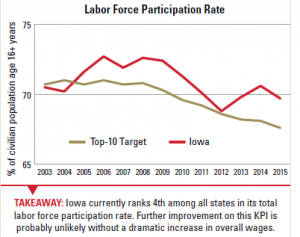
In-migration flows increase the size of Iowa’s workforce pool at the expense of other states and countries. So net migration (the net increase) is a good aggregate measure of various recruitment tactics, including recruitment of veterans, dislocated former Iowans, and young professionals.
Iowa has shown slight improvement on its net migration rate in recent years, after several years of suffering net losses. We attracted 1.47 net new migrants per 1,000 residents in 2014, ranking 26th among all states.
EDUCATE
Considering the constraints on the size of Iowa’s overall labor force, another avenue for growing the number of skilled workers is to increase the educational attainment of labor force members. We propose two education-related measures. The first is the number of STEM degrees or certificates completed per 1,000 Iowa residents.
Based on analysis of degree completions at post-secondary institutions, Iowa currently ranks 5th nationally with 2.8 STEM degrees/certificates granted per 1,000 residents. However, analysis by the data firm EMSI shows that Iowa ranks 38th in its percentage of STEM jobs in the economy. The disparity between those rankings suggests that Iowa might already be struggling to absorb all of the STEM graduates produced by its educational institutions.
Another pair of education metrics focuses on the educational achievement of Iowans. Iowa currently ranks 4th nationally, with 15.0 percent of its 18–64 population having completed an associate degree. (The national average is 9.8 percent.) In contrast, only 29.1 percent of Iowa’s 18–64 population has four-year college degrees, which ranks 25th among the states.
RETAIN
Obviously, one of the easiest ways to solve a hiring problem is to keep the workforce you already have. Workers tend to commit strongly to companies with a positive culture and generous benefits (traits that also tend to attract workers from other companies). A common way for individual firms to measure retention is turnover rate—the fraction of your workers who quit and must be replaced each year. At the statewide level, a comparable metric is the replacement hiring rate, which measures the average number of hires (not counting new job creation) as a percentage of employment. During 2014, Iowa’s replacement hiring rate of 6.9 percent ranked 18th (lowest) among the states.
REINVENT
Firms that are unable to find new workers may ultimately move toward more automated systems. Unfortunately, no metrics are available to describe the level of automation within or across industries. Here we simply compare the number of workers relative to annual capital investment in the manufacturing sector, following the assumption that more automated processes should require fewer workers per dollar of capital.
Iowa’s manufacturing sector had approximately 56 workers per $1 million in capital investment in 2013.
Another way to grow sales without increasing the number of employees is to implement continuous improvement strategies and then move the employee resource to areas of sales growth.
Absent any economy-wide measure of productivity strategy adoption, we examine the number of workers required to produce every $1 million of gross domestic product (GDP). This metric is not ideal because industries vary in their productivity levels and states vary in their industrial mix. It does, however, give a general sense of a state’s relative position and whether or not it is improving over time. Iowa had 13.3 workers per $1 million in GDP in 2014, down from 17 workers in 1988.
The Bottom Line
Regardless of which strategy you choose, metrics must be tracked and evaluated to make certain you’re making the right decision. None of the measures we’ve presented above are magic bullets. They will not have the same impact on all companies or all regions, because companies and regions can be different in key ways. Company leaders should follow key metrics and make decisions based on the implementation cost of each strategy and what potential yield may come from the result.
From a statewide perspective, we believe the data strongly suggest a potential area of focus. Iowa already ranks among the top 10 states in three KPIs: STEM degrees/certificates, percent of population with an associate degree, and labor participation rate. Protecting rather than improving on these strengths may be a reasonable goal. For instance, if Iowa dropped from 4th place to 10th place in labor force participation rate, the loss to its overall labor force would be more than 50,000 workers.
In contrast, Iowa does not rank as high as many other states in net migration, replacement hiring rate, and ratios comparing employment to capital investment and GDP. Developing new strategies in these areas might be a reasonable goal.
This article was written by Ron Cox and Liesl Eathington for publication in the Spring 2016 edition of CIRAS News. To read more of that edition or others, please explore elsewhere on our website.

